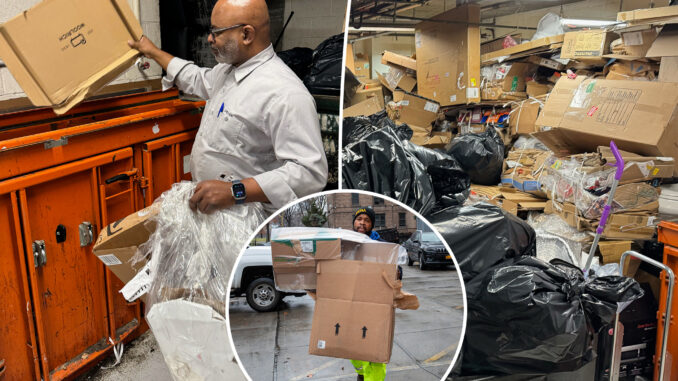
What comes in must go out.
So once all those holiday boxes are delivered, opened and done with, the discarded cardboard then becomes the super’s headache.
The cardboard economy exploded during COVID due to a cascade of home deliveries — and it expands even more during gift-giving season, with building supers these days finding themselves buried in boxes.
“On a regular recycling night, outgoing cardboard is double the amount of regular trash,” said Dominick Romeo, the super of a 60-unit Chelsea condominium. “During the holidays, it is triple the amount. It’s overwhelming. It’s almost not manageable.”
In his basement, Romeo — the activist super aiming to repeal the sanitation department’s new trash set-out times — has created a pocket made of bungee cords and construction netting, so residents can securely prop their flattened boxes against the wall, saving floor space.
The pocket can become overfilled with cardboard — lightweight but unwieldy — within hours, he said. He empties it as often as needed, then bundles the cardboard tightly with twine, as city sanitation rules require.
Supers can also set out their cardboard recycling in clear plastic bags, the preferred approach for Jose Rodriguez, the super for several small Manhattan condo buildings. He collects refuse floor by floor. “From Thanksgiving to the second week of January, it’s out of control,” he said.
He instructs his residents in the proper breakdown of boxes, though they still sometimes discard intact boxes. His small refuse rooms can become so crammed that “when I open the door, the boxes fall out,” he said. People rarely remove the box’s address label, so identifying — and warning — the culprit is easy.
Not everyone faces this holiday-season headache. Some bigger buildings have turned to cardboard balers. The machines clear space and reduce labor for both sanitation workers and supers.
“Instead of picking up eight bundles of cardboard, they pick up one,” said John Frustaci, an engineer at Premier Compaction Systems in New Jersey, supplier of many of the city’s balers.
The source of the problem, Frustaci said, is that buildings were built before cardboard culture took hold. “We really need to understand how to manage the cardboard in the building-design stage,” he said.
The Clark, a 170-unit rental building in Prospect Lefferts Gardens, added a baler three years ago. “Today, Amazon dropped 137 packages in one shot,” said resident manager Sucre Lopez, who stores the overflow from the package room in his office.
His building’s baler is the envy of his friends who don’t have one. “Everything is packed tight and neat,” Lopez said. “The baler has been a blessing.”
Some of his super friends have trash chutes, which residents recklessly stuff with cardboard boxes. “To throw down boxes you have to have it in pieces and fold it really neat,” Lopez said. “They don’t do that and the chute gets clogged and it is a nightmare for the staff. Sometimes they have to use a water hose from the top.”
One big cardboard handler is the NYC Housing Authority, which added balers three years ago, and now has 40 of them in 35 locations. During the last two holiday seasons, NYCHA saw an uptick of approximately 30% in routine cardboard tonnage, said Keith Grossman, Executive Vice President for Operations Support Services, who oversees waste management.
“The balers are great for medium and small boxes,” Grossman said. “The large boxes are a challenge.” The worst are flat-screen TV boxes — enormous and sturdy — which must be cut into manageable pieces.
Other problematical boxes are those with structural support components — brackets, nails or staples — which also pose a stabbing hazard for supers. Water-resistant waxed boxes, often used to ship fresh fruit, are especially strong and tough to deconstruct.
It’s not just during the holidays. NYCHA workers also contend with a surge of gigantic TV boxes — sometimes 75 inches or more — during tax-refund season and in the weeks before Super Bowl Sunday, both of which are approaching.
The massive Orion Condominium in Midtown West — with 60 floors and 551 units — has a staff of 24, including 11 porters. “Five years ago, nobody knew the delivery box would be an epidemic,” said Danny Sifonte, the resident manager.
His building was an early convert to balers. With the staff snowed under by outgoing cardboard, “I had to think of a better idea of what to do,” he said. He was familiar with hydraulic machinery and remembered that supermarkets used balers. “That was my golden moment,” he said.
His porters keep a close eye on each floor’s service area, currently clearing the bulky boxes two to four times a day.
“Our cardboard boxes are such a huge issue that we have a private carting company that additionally comes in,” Sifonte said. The holiday season consumes most of his carting budget. The carting company might be summoned once a month in the summer, but two or three times a month during the busy season.
Even so, bales of cardboard line the sidewalk — which adds another problem.
“The homeless people will open up the bales because they want a big box to sleep in,” Sifonte said. “They will cut the band off and take whatever box they want. The bale explodes like popcorn.”
Real Estate – Latest NYC, US & Celebrity News



